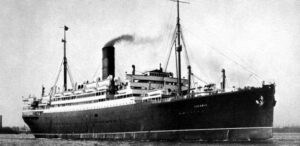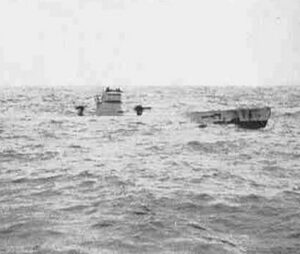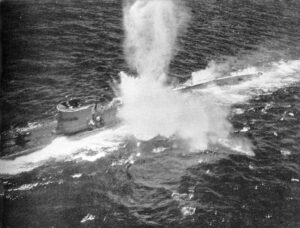 Probably one of the deadliest weapons the Nazis ever created, was the German U-Boat. With their code system, it was hard to track a U-boat, and so they snuck up on ships and sunk them. The U-boat wasn’t a ship. It was a submarine, so the ships didn’t know it was there until they saw the torpedo coming at them…if they saw it coming. Often, they didn’t see it coming, it just hit, and it was over. On September 12, 1942, a U-boat sunk the British troop ship, the RMS Laconia, killing more than 1,400 men. The commander of the German sub, Captain Werner Hartenstein, then realized that Italians POWs were among the passengers.
Probably one of the deadliest weapons the Nazis ever created, was the German U-Boat. With their code system, it was hard to track a U-boat, and so they snuck up on ships and sunk them. The U-boat wasn’t a ship. It was a submarine, so the ships didn’t know it was there until they saw the torpedo coming at them…if they saw it coming. Often, they didn’t see it coming, it just hit, and it was over. On September 12, 1942, a U-boat sunk the British troop ship, the RMS Laconia, killing more than 1,400 men. The commander of the German sub, Captain Werner Hartenstein, then realized that Italians POWs were among the passengers.
Like many other cruise ships, the Laconia, a former Cunard White Star ship was put to use to transport troops, including prisoners of war during World War II. RMS Laconia was in the South Atlantic bound for England when  it encountered U-156. The sub attacked, sinking the troop ship and imperiling the lives of more than 2,200 passengers. But as Hartenstein, the sub commander, was to learn from survivors he began taking onboard, among those passengers were 1,500 Italian POWs. Of course, it wouldn’t look good for Hartenstein to be responsible for endangering the lives of so many of his fellow Axis members, so he quickly put out a call to an Italian submarine and two other German U-boats in the area to help rescue the survivors.
it encountered U-156. The sub attacked, sinking the troop ship and imperiling the lives of more than 2,200 passengers. But as Hartenstein, the sub commander, was to learn from survivors he began taking onboard, among those passengers were 1,500 Italian POWs. Of course, it wouldn’t look good for Hartenstein to be responsible for endangering the lives of so many of his fellow Axis members, so he quickly put out a call to an Italian submarine and two other German U-boats in the area to help rescue the survivors.
Upon hearing of the incident, one French and two British warships rushed to the scene to aid in the rescue. The German subs immediately informed the Allied ships that they had surfaced for humanitarian reasons. The Allies wisely assumed it was a trap. With that, an American B-24 bomber, the Liberator, flying from its South Atlantic base on Ascension Island, saw the German sub and bombed it…despite the fact that Hartenstein had draped a Red Cross flag prominently on the hull of the surfaced sub. The U-156, damaged by the air attack, immediately  submerged. Admiral Karl Donitz, supreme commander of the German U-boat forces, had been monitoring the rescue efforts. He ordered that “all attempts to rescue the crews of sunken ships…cease forthwith.” Consequently, more than 1,400 of the RMS Laconia’s passengers, which included Polish guards and British crewmen, drowned. This marked the end of taking POWs from torpedoed ships. There were often men who survived these attacks, but they were given no chance of survival after the attack. I suppose war is war, and death is expected. On March 8, 1943, U-156 was sunk by PBY “Catalina” aircraft from Patrol Squadron Fifty-Three (VP-53), in the Atlantic Ocean, east of Barbados. There were five survivors from U-156.
submerged. Admiral Karl Donitz, supreme commander of the German U-boat forces, had been monitoring the rescue efforts. He ordered that “all attempts to rescue the crews of sunken ships…cease forthwith.” Consequently, more than 1,400 of the RMS Laconia’s passengers, which included Polish guards and British crewmen, drowned. This marked the end of taking POWs from torpedoed ships. There were often men who survived these attacks, but they were given no chance of survival after the attack. I suppose war is war, and death is expected. On March 8, 1943, U-156 was sunk by PBY “Catalina” aircraft from Patrol Squadron Fifty-Three (VP-53), in the Atlantic Ocean, east of Barbados. There were five survivors from U-156.


Leave a Reply